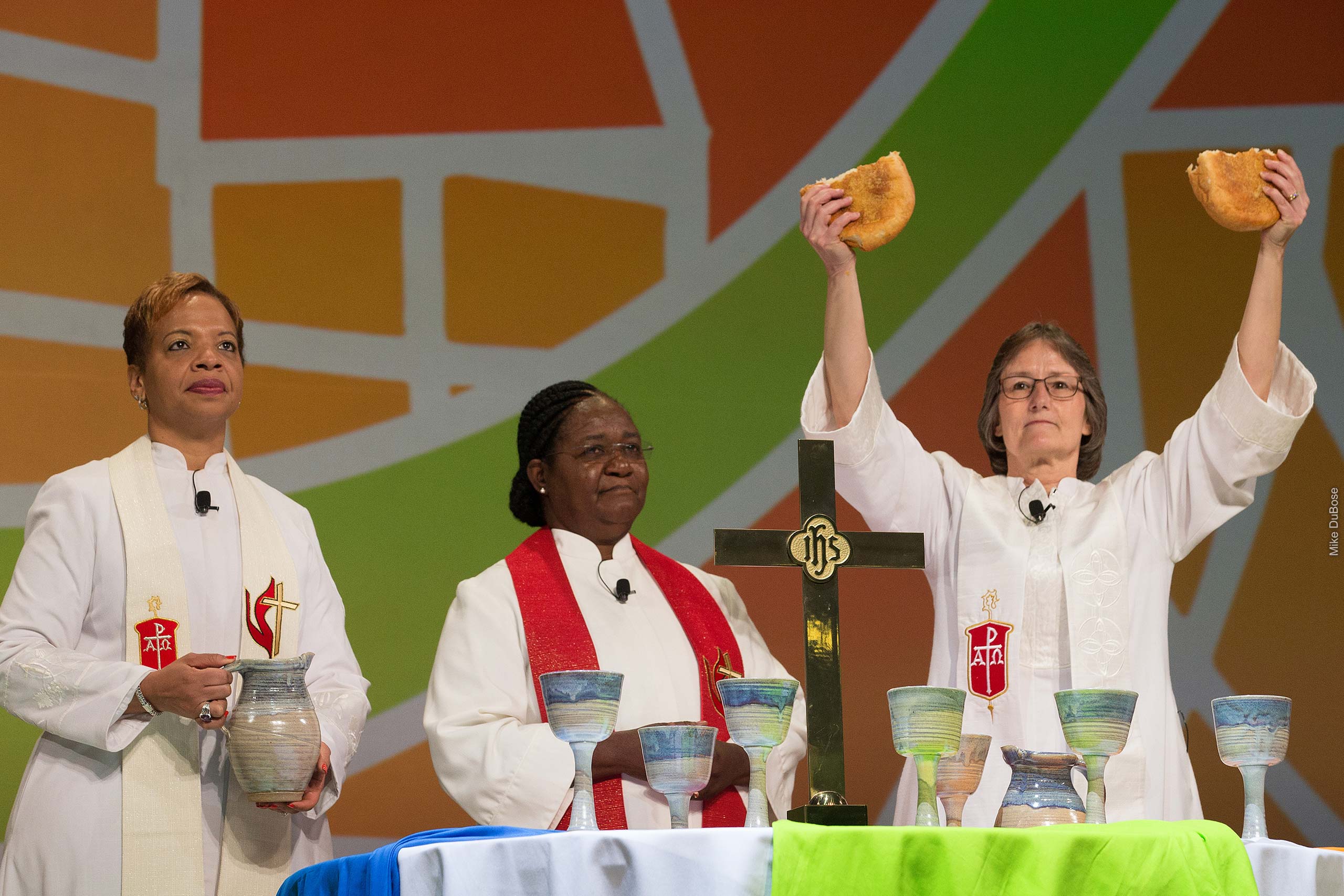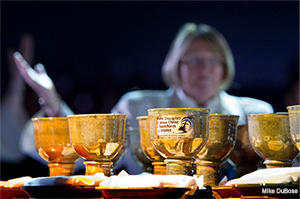
Latest News
None but the Pure Juice of the Grape
Women’s organizing is at the root of why United Methodists use grape juice for communion.
by Tara Barnes
Last spring I participated in a podcast for the United Methodist General Commission on Archives and History called Un-tied Methodism. The podcast is hosted by General Secretary Ashley Boggan Dreff and examines the roots of The United Methodist Church to understand why the church is the way it is. The episode topic was “Welch’s Grape Juice and Methodism.”
Why was the editor of the women’s magazine asked to be on a podcast about grape juice? It makes more sense than you might think.
Juice of the red grape
Growing up United Methodist, it never occurred to me to consider it odd that we used grape juice for the communion cup. I have fond childhood memories not only of receiving communion but of finishing the leftover juice with friends in the church kitchen after worship. I felt a little bad, even, for Christian friends whose churches used wine for communion. Communion, for me, was a treat.
The United Methodist Book of Worship explains, “Although the historic and ecumenical Christian practice has been to use wine, the use of unfermented grape juice by The United Methodist Church and its predecessors since the late nineteenth century expresses pastoral concern for recovering alcoholics, enables the participation of children and youth, and supports the church’s witness of abstinence.”
As I grew in curiosity and commitment in my United Methodist faith and asked about our use of grape juice, trusted sources offered explanations similar to that described in the Book of Worship, but with one consistent extra bit of information: The Welches were Methodist.
I spent a good part of my life amused by the idea that my church’s use of grape juice may be a holy kickback for the Welch family, but I had my timeline wrong. Thomas Welch, a dentist in New Jersey, created grape juice because he was a communion steward at a Methodist church at a time before home refrigeration was available. (Grapes quickly ferment when left unrefrigerated.) Welch’s grape juice exists today because Welch wanted to provide a non-alcoholic alternative to wine, which he called Dr. Welch’s Unfermented Wine. This Holy Mystery, the official interpretive statement of theology and practice of communion for The United Methodist Church, today names the element to be shared as “the juice of the red grape.”
What’s wrong with wine?
Nothing is wrong with wine—it was Jesus’ first miracle, after all, and what he shared with his disciples at the very first communion. It’s what many Christians use today and what even Methodists used for communion in a time when preventing fermentation was nearly impossible and alcohol-free raisin concoctions nearly undrinkable. Founder of Methodism John Wesley called wine “one of the noblest cordials in nature” in his Sept. 9, 1771, journal entry. What John Wesley preached against was the dangers of drunkenness.

“You have forced the spirit of God to depart from you!” Wesley wrote in his 18th-century treatise “A Word to a Drunkard” about the dangers of imbibing too much spirituous liquor. “You have given yourself up to the hands of the devil.”
Drunkenness, Wesley said, led people to sin in ways they wouldn’t otherwise: “Will you run the hazard of committing all manner of villanies; and this only for the poor pleasure of a few moments, while the poison is running down your throats?”
A sip of wine at communion was not what worried Wesley. So what led United Brethren and Methodists to eventually adopt the mandatory rubrics “always securing unfermented wine” (United Brethren in Christ in 1889) and “let none but the pure juice of the grape be used in administering the Lord’s Supper” (Methodist Episcopal Church in 1916) in their books of discipline? If you’ve read the mission study Women United for Change celebrating United Methodist Women’s 150th anniversary, you know the answer.
Women organizing for change
It wasn’t just coincidence that Welch invented grape juice the same year the Woman’s Foreign Missionary Society of the Methodist Episcopal Church was formed, in 1869. Women in the United States were organizing themselves for the causes they believed in, one of which was temperance, or abstinence from alcohol. Many of these women, like Wesley, believed drunkenness to be sinful and counterproductive, but the temperance movement was about so much more than moral condemnation. We can look back and call the women’s behavior as buttoned-up as their dresses, but we’d be wrong.
By the 1800s, distilled spirits had become widely available in the United States, beverages that had a much higher alcohol content than the beer and cider drank at many meals. Ken Burns explains in his documentary Prohibition, “by 1830, the average American over 15 years of age drank the equivalent of 88 bottles of whiskey a year—3 times as much as their 21st-century descendants drink. Americans spent more money on alcohol each year than the total expenditures of the federal government.” The country’s poorhouses, workhouses, and prisons were full of inebriates.
It wasn’t a glass of wine with dinner that birthed a cross-cultural, cross-political movement that led to two amendments to the U.S. Constitution; alcohol abuse was prevalent, and so were its effects. And those profiting most from the sale of alcohol weren’t the communities most harmed.
When the temperance movement began, slavery was legal in the United States. Enslaved Africans and their descendants were treated as property by white colonizers and forced to work at labor camps on land stolen from Native Americans. Though in time both the temperance and suffragist movements would center white women at the expense of people of color, the initial push to curb alcohol use was an intersectional movement among marginalized communities and went hand-in-hand with work to abolish slavery. Famous abolitionists like Frederick Douglass and Methodist Sojourner Truth spoke in favor of temperance as a critical part of securing racial and gender justice. Groups worked together to curb alcohol abuse, which they saw as a root of many social problems.
Even unenslaved white women were second-class citizens in the 19th century, with few legal rights. They were dependent on men for their and their families’ livelihood. Money for food and clothing was being spent instead on alcohol, the abuse of which led men to be neglectful partners at best and violent at worst. As formal women’s societies began to form, outlawing the sale of alcohol was seen as a solution to their goals of uplifting society.
The Woman’s Christian Temperance Union was co-founded in 1874 by Methodist woman Frances Willard, who became the organization’s president in 1879. Women, however, had been leading temperance crusades in the United States from the early 1800s.
An editorial praising the work of organized women in the September 1879 issue of Heathen Woman’s Friend, the magazine of the Woman’s Foreign Missionary Society of the Methodist Episcopal Church, stated, “The date of the first woman’s temperance society was not by any means the date of woman’s first work for temperance. In each of the great temperance reformations in the first half of this century, women were a mighty co-operating factor. So in the work of foreign missions, so in the work for the abolition of slavery. Sojourner Truth’s word was as thrilling as Garrison’s, Mrs. Stowe’s many times farther sounding. Even organized forms of female effort were found in abundance. Hardly a local church has been able to thrive without a sewing-circle, hardly a missionary society which did not have female auxiliaries, hardly a reform movement failed to enroll women.”
Willard was one of the five women first elected to the Methodist Episcopal General Conference in 1888 (elected but not seated). Under Willard, the WCTU became politically active and worked for various social reforms. Willard believed women had a key role to play in building a more Christ-like society as “protectors of the home.” Women needed to secure voting rights in order to enact prohibition and set other moral standards such as a raised age of consent, labor and prison reform, food and drug regulation, leadership and education for women, and more. Many members of the WCTU were members of the WFMS, and vice versa. Temperance was a cause of many WFMS groups, named frequently in the society’s publications. The now United Methodist Building on Capitol Hill in Washington, D.C., was constructed in 1923, primarily to house the offices of the Board of Temperance, Prohibition, and Public Morals. Funds for the building came from individual donors, 70 percent of whom were women, according to the United Methodist General Commission on Archives and History.
Is my podcast appearance making more sense now?
Reckoning with history
As Willard worked to recruit Southern women to the WCTU, the national organization made accommodations to allow local chapters to remain racially segregated and not support national causes like suffrage and anti-lynching. In an 1890 interview with New York Voice, according to the Frances Willard House Museum, Willard blamed Black voters for the failure of prohibition bills in the South and made other comments that perpetuated the myth that Black men were more prone to drunkenness and violence and were a threat to White women. Famous White feminists like Elizabeth Cady Stanton and Susan B. Anthony fought vocally against the 15th Amendment, which in 1870 removed Black men’s barriers to voting, arguing that educated White women deserved voting rights first.
This movement with roots in abolition and working in coalition took a sharp turn toward White supremacy once civil rights became perceived as something over which to compete, a pattern we still reckon with today. The racial makeup of The United Methodist Church in the United States is more than 90 percent White, a statistic that does not reflect the demographics of our country. Women still aren’t equally represented or paid in leadership positions in the denomination. Our organization’s first magazine was titled Heathen Woman’s Friend. We can’t learn from our mistakes if we don’t acknowledge them. If it’s in United Methodists’ spirits to create a brand-new drink in order to ensure all can be welcome at our communion table, that same spirit should extend to all of our tables.
A passion to serve God
The 18th Amendment to the U.S. Constitution was ratified in 1919, prohibiting the manufacture, sale, or transportation of intoxicating liquors in the United States. The Volstead Act, or National Prohibition Act, soon followed, which defined and enforced the 18th Amendments restrictions. A year later, White women would get the vote.
Though the 21st Amendment would repeal the 18th Amendment 14 years later, and popular history would paint the experiment a failure, Prohibition did reduce alcohol abuse and the effects thereof, a flattening effect that lasted long after. And it gave us grape juice.
In his will, Welch’s son Charles described the origins of the juice: “Unfermented grape juice was born in 1869 out of a passion to serve God by helping [God’s] Church to give its communion ‘the fruit of the vine,’ instead of the ‘cup of devils.’” Welch didn’t invent his unfermented wine as an entrepreneurial venture but as a gift of welcome, part of a crusade, driven by women, to support the marginalized.
Welch’s grape juice is a widely available and popular product today thanks to Charles Welch, who saw the opportunity to market the new drink. Charles Welch too was a dedicated Methodist, serving as a delegate to General Conference four times—where he surely supported the church’s use of unfermented wine. He also ran for multiple public offices as part of the Prohibition Party. (Maybe that wink with which my Methodist mentors told me about the Welches being Methodist wasn’t so off-base.)
We may have Thomas and Charles Welch to thank for grape juice, but we have our foremothers to thank for the movement that inspired it.
Tara Barnes is director of denominational relations for United Women in Faith.

